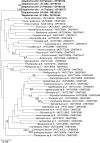LAMP assay for the detection of the Asian citrus psyllid, Diaphorina citri Kuwayama (Hemiptera: Psylloidea: Psyllidae)
- PMID: 37407637
- PMCID: PMC10322826
- DOI: 10.1038/s41598-023-37721-w
LAMP assay for the detection of the Asian citrus psyllid, Diaphorina citri Kuwayama (Hemiptera: Psylloidea: Psyllidae)
Abstract
Diaphorina citri Kuwayama, also known as the Asian citrus psyllid (ACP), can vector the bacterium Candidatus Liberibacter asiaticus (CLas), agent of Huanglongbing (HLB): an incurable disease affecting citrus trees worldwide. In citrus growing regions where ACP and HLB are absent, such as Australia, the risk of an incursion and consequent economic damage to citrus industries make this psyllid one of the top-priority pests. Due to ACP's small dimensions and the generally poorly studied native psylloid fauna worldwide, morphological identification of this insect to distinguish it from harmless species is challenging, especially in the field, and with immature, partial or damaged specimens. To allow rapid and efficient detection of ACP in the field, we designed and optimised a new Loop-mediated isothermal amplification (LAMP) assay for the detection of D. citri based on the mitochondrial 16S locus. The optimised ACP 16S LAMP assay produced amplification from D. citri samples within 13.3 ± 3.6 min, with an anneal derivative of ~ 78.5 °C. A synthetic gBlock gene fragment was also developed to be used as positive control for the new LAMP assay with a different anneal derivative of ~ 83 °C. An existing commercially available LAMP assay for detection of the bacterium CLas was also tested in this study on ACP DNA. The ACP 16S LAMP assay we developed and tested here provides a valuable new in-field compatible tool that can allow early detections of ACP, enabling a quick biosecurity response, and could potentially be adopted by a wide range of users, from farmers to agronomists and from researchers to industry.
© 2023. Crown.
Conflict of interest statement
The authors declare no competing interests.
Figures





Similar articles
-
Distribution and Variation of Bacterial Endosymbiont and "Candidatus Liberibacter asiaticus" Titer in the Huanglongbing Insect Vector, Diaphorina citri Kuwayama.Microb Ecol. 2019 Jul;78(1):206-222. doi: 10.1007/s00248-018-1290-1. Epub 2018 Nov 24. Microb Ecol. 2019. PMID: 30474731
-
Foliar Antibiotic Treatment Reduces Candidatus Liberibacter asiaticus Acquisition by the Asian Citrus Psyllid, Diaphorina citri (Hemiptera: Liviidae), but Does not Reduce Tree Infection Rate.J Econ Entomol. 2023 Feb 10;116(1):78-89. doi: 10.1093/jee/toac200. J Econ Entomol. 2023. PMID: 36516405
-
Identification and Distribution of the 'Candidatus Liberibacter asiaticus'-Asian Citrus Psyllid Pathosystem in Saudi Arabia.Plant Dis. 2024 Apr;108(4):1083-1092. doi: 10.1094/PDIS-07-23-1460-RE. Epub 2024 Apr 22. Plant Dis. 2024. PMID: 37953230
-
Progress and Obstacles in Culturing 'Candidatus Liberibacter asiaticus', the Bacterium Associated with Huanglongbing.Phytopathology. 2019 Jul;109(7):1092-1101. doi: 10.1094/PHYTO-02-19-0051-RVW. Epub 2019 Jun 3. Phytopathology. 2019. PMID: 30998129 Review.
-
Integrated Pest Management Strategies for Asian Citrus Psyllid Diaphorina citri Kuwayama (Hemiptera: Psyllidae) and Huanglongbing in Citrus for Sarawak, East Malaysia, Borneo.Insects. 2022 Oct 20;13(10):960. doi: 10.3390/insects13100960. Insects. 2022. PMID: 36292909 Free PMC article. Review.
Cited by
-
Rapid detection of the invasive tomato leaf miner, Phthorimaea absoluta using simple template LAMP assay.Sci Rep. 2025 Jan 2;15(1):573. doi: 10.1038/s41598-024-84288-1. Sci Rep. 2025. PMID: 39747526 Free PMC article.
References
-
- Burckhardt D, Ouvrard D, Percy DM. An updated classification of the jumping plant-lice (Hemiptera: Psylloidea) integrating molecular and morphological evidence. Eur. J. Taxon. 2021;736:137–182. doi: 10.5852/ejt.2021.736.1257. - DOI
-
- Hollis D. Australian Psylloidea, Jumping Plantlice and Lerp Insects. Australian Biological Resources Study; 2004.
-
- Jarausch B, Tedeschi R, Sauvion N, Gross J, Jarausch W. Psyllid Vectors. In: Bertaccini A, Weintraub P, Rao G, Mori N, editors. Phytoplasmas: Plant Pathogenic Bacteria–II. Springer; 2019.
-
- Stansly, P. A. & Qureshi, J. A. Management Objectives and Integration of Strategies for the Asian Citrus Psyllid. In Asian Citrus Psyllid, Biology, Ecology and Management of the Huanglongbing vector (eds. Qureshi, J. A. & Stansly, P. A.) 166–178 (CABI, 2020).
Publication types
MeSH terms
Supplementary concepts
LinkOut - more resources
Full Text Sources

